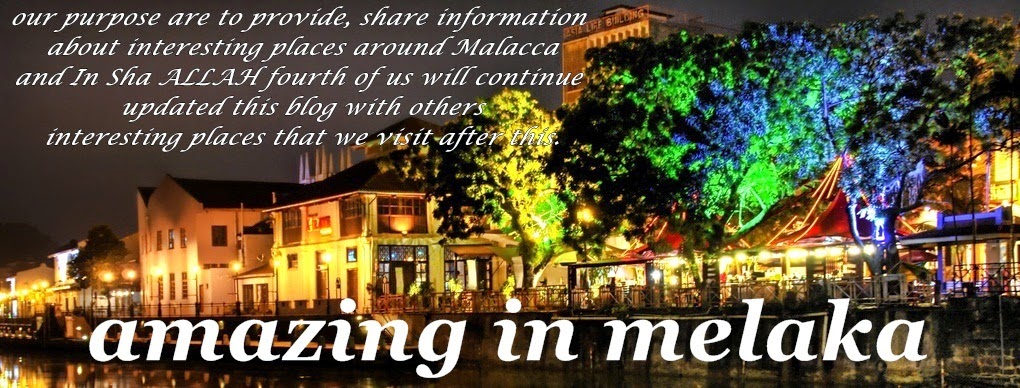Located next to
the Stadthuys Complex, Christ Church is the oldest
functioning Protestant church in Malaysia and is placed within the jurisdiction
of the Lower Central Archdeaconry of the Anglican Diocese of West
Malaysia. Christ Church is also the
oldest surviving Dutch church building found outside the Netherlands and Sunday
services are still held in this church.
History of Christ Church
In 1641, the Dutch conquest of Malacca from the Portuguese
Empire saw the proscription of the Roman Catholicism and the conversion of
existing churches for the Dutch Reformed use. The old St. Paul’s Church at the
summit of St. Paul Hill was renamed the “Bovenkerk” (High Church) and used as
the main parish church of the Dutch community.
In 1741, in commemoration of the centenary of the capture of
Malacca from the Portuguese, the Dutch burgher community decided to build a new
church to replace the aging “Bovenkerk”. The foundation stone for the new
church was laid by the Malacca born Captain of the Malacca Burghers, Abraham de
Wind on 18th February 1754, on behalf of his father, Claas de Wind. Claas de
Wind was a prominent Burgher who had been the Secunde (Deputy Governor) of
Malacca but was too ill to partake in the historic ceremony. The church took a
staggering 12 years to complete and later in 1753, replaced the “Bovenkerk” as
the primary Dutch Reformed Church in Dutch Malacca. The Portuguese fort walls
and the “Bovenkerk”, however, were demolished by the British at the beginning
of the 19th century.
Christ
Church bears all
the hallmarks of the 18th-century Dutch architecture: a rectangular plan in a
perfect 2:1 proportion: 82 feet by 42 feet; the 40 feet ceiling supported
by a span of immense wooden beams which each were cut from a single tree; the
roof covered with Dutch tiles; the massive walls raised using Dutch bricks
built on local laterite blocks and then coated with Chinese plaster.
The granite bricks which pave the
floor in Christ Church were brought
to Malacca as ship’s ballast to keep the ship upright and afloat as they rode
with the ocean’s wind and waves. The incised letters found on some of them are
evidently storage marks. Upon reaching Malacca, the sailors would be ordered to
unload the granite bricks to be used for construction in Malacca. The ballast
was then replaced with commercial merchandise for their continued journey,
sailing either to Indonesia, to other Dutch colonies in Asia or back to the
Netherlands.

The floors of Christ Church also
incorporate various tombstones with Portuguese and Armenian inscriptions used
as paving blocks. The tombstones that are written in Portuguese were originally
in St. Paul’s Church inside the Portuguese fortress. However, they were removed
by the Dutch when they occupied Malacca in 1641. Since it is unlikely that the
religious Dutch would have used Catholic tombstones inside a Protestant church,
historians surmise that they were installed there by the British. Memorial
plaques in Dutch, Armenian and English also adorn the interior of Christ Church.
The church bell inscribed with the date 1698, suggesting that it
was used for another purpose prior to the completion of the church. The
church’s collection of “Kerk Boek” (Church Book), “Resolutie Boek” (Resolution
Book), “Rapporten” (Reports) as well as the “Doop Boek” (Baptism Register)
going back to the earliest Dutch times in Malacca have survived through the
centuries. These antiquated documents are now being kept at the National
Archives of Malaysia.
Christ
Church also has
in its possession a fine collection of extremely rare silver vessels that could
traced back to the early Dutch period. This priceless collection is now kept
safe in a vault of a bank and is hardly brought out to be exhibited for the
public. The altar Bible has a brass cover inscribed with the passage from
John 1:1 in Dutch.
The Anglo-Dutch
treaty was signed on 17 March 1824, which effected the exchange of Dutch and
British possessions in India and the East Indies, and Malacca was
reassigned to the British for Bencoolen (now Bengkulu) at Sumatra. The
British occupied Malacca at the beginning of April 1825 and the town was then
placed under the direct authority of the English Bengal Government. In 1838,
the church was re-consecrated with the rites of the Church of England by the
Rt. Rev. Daniel Wilson, the Anglican Bishop of Calcutta and renamed Christ Church.
The maintenance
of the church was taken over by the Government of the Straits Settlements in
1858. Under the British colonial administration, the building of Christ Church had undergone
some minor changes. Its original Dutch windows were reduced and ornamented
while the porch and vestry were built in the mid-19th century.
During the
Dutch rule of Malacca, the church, like many other Dutch buildings in South
East Asia was painted white. However, in 1911 the Christ Church and the Stadthuys Complex were
painted red by the British. The reason for the change of the colour scheme for
these two buildings now remains unknown. Since then, Malacca’s red buildings
have become a hallmark of the Dutch influence in the town.
Important Events
6 March 1972 – Queen Elizaberth
II visited the Malacca and prayed at Christ
Church with the royal party, which included the Duke of Edinburgh,
Princess Anne and the now late Lord Louise Mountbatten.
13 December 2003 – Christ Church celebrated
it’s 250th anniversary. Headed by Pastor Batumalai of the Anglican
parishioners, the celebration began with a spiritual thanksgiving service and
followed by a grand dinner in the ballroom of a hotel in Malacca.
Location
Address: 48, Jalan Gereja, 75000 Melaka
GPS Coordinate:
N 2.194462, E 102.249498
Contact Details
Christ Church
48, Jalan Gereja
75000 Melaka
Tel: 06-2848804
H/P : 017-6743199 (Rt Rev Dr. S. Batumalai)
Email: christchurchmelaka@gmail.com











